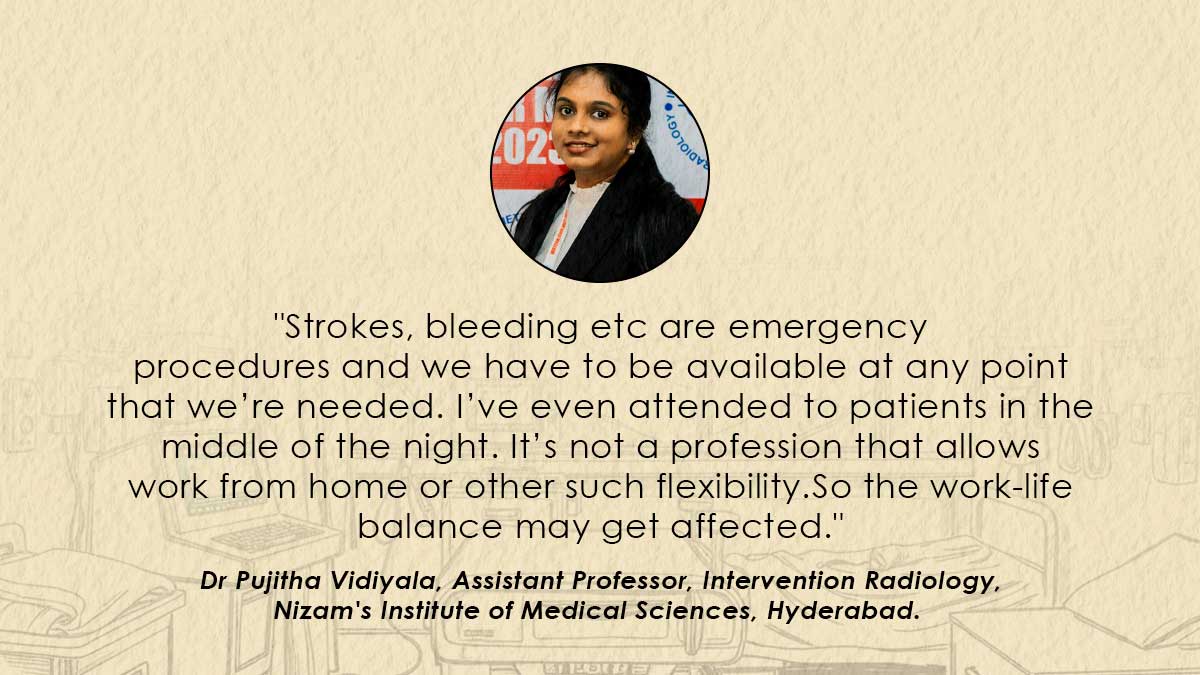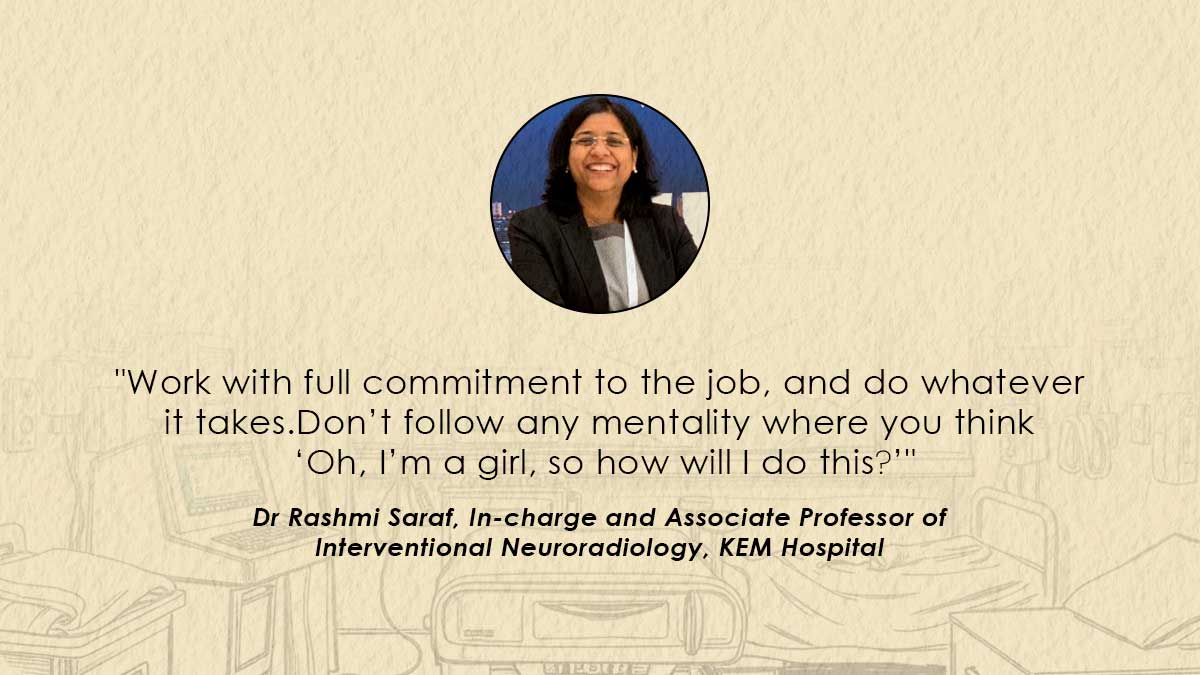-1732706382464.webp)
Why Women Are Missing in Interventional Radiology—and How Increasing Their Numbers Could Bridge Healthcare Gaps
Interventional Radiology is a specialised branch of radiology, that uses imaging technologies—such as X-rays, CT scans, MRI, and ultrasound—to guide minimally invasive procedures for diagnosing and treating various conditions. It has a wide range of applications, from removing clots, and varicose veins, to draining excess fluids, interventional radiology finds use in various parts of the body.
When asked to explain in layman's terms, Dr Poorvi Malik, Assistant Professor in Dept of Intervention Radiology, Mahatma Gandhi Medical College and Hospital, Jaipur, said, “Interventional radiology is like an even more, minute form of laparoscopic surgery. We perform surgeries on blood vessels of the body, and we go through a hole, that is the size of a needle. So the recovery time in such cases is the span of a few hours.” These surgeries are performed in various parts of the body without opening them. Interventional radiology is a field doctors pursue after doing MD Radiology. The doctors in this branch also work when there’s been excessive bleeding, or a particular drug has to be delivered to a particular area of the body.
However, there’s a stark under-representation of women in the field. As highlighted by this study by Jenny M. Gandhi, women represent only 11% of IR consultants in the United Kingdom, 34% in the United States, and 3.5% in India. However, the report added that half of the medical students in the world are women. Dr. Poorvi validated the point, saying about 30-35% of students pursuing diagnostic radiology are women but the number drops to 3-3.5% for interventional radiology.
1
2
3
4
Read: How Social Media And Therapy Speak Could Be Ruining Relationships
We speak to four radiologists from across the country to understand why this gap exists, and how bridging it, may help reduce further healthcare gaps in the country.
Fears Around Radiation, and Its Health Impacts
One of the primary reasons women shy away from IR is the misconception that exposure to radiation adversely affects fertility.-1732707022450.jpg)
“If you wear proper radiation protection devices, you would be safe. Earlier they would have heavy protective aprons but now they have lead-free feather-light garments that offer the same level of protection from radiation,” she said. “There also exists badges that monitor how much radiation we’re being exposed to. These get renewed every three months. However, I’ve never seen the safety levels be crossed.”
Dr Tanya Yadav, Assistant Professor at Sanjay Gandhi Post Graduate Institute of Medical Sciences (SGPGI), Lucknow highlighted how abroad, people treat patients even during pregnancy, further squashing myths around radiation affecting fertility or childbearing abilities. “If you’re putting on adequate protection, you can work during pregnancy too. Here in India, nobody enters the lab during pregnancy. I am 32, I have decided to work through my pregnancy,” she added.-1732706979313.jpg)
Dr Tanya also added that she faced some gender-based discrimination while appearing for interviews as well, where she’d be asked how she’d manage in this field if she was planning to have a family. “I heard things like “You’ll not be able to work late”, “You’ll not be able to come for emergencies” etc,” she said, to highlight some ingrained biases even among doctors.
Lack of a Work-Life Balance
Being a branch where emergencies are common, there are calls and duties to attend to, often at odd hours.
A lot of people in general opt for general radiology as a branch, as it's possible to have fixed hours. It is touted to be a more comfortable branch. However, interventional radiology being a clinical branch, requires doctors round the clock. “Strokes, emergency bleedings etc are emergency procedures and we have to be available at any point that we’re needed. I’ve even attended to patients in the middle of the night too. It’s not a profession that allows work from home or other such flexibility. So the work-life balance may get affected,” said Dr Pujitha Vidiyala, Assistant Professor, Intervention Radiology, Nizam's Institute of Medical Sciences, Hyderabad.
Given the added responsibility on women, where they have to often balance housework and their professions, this factor of odd and long hours tends to act as a deterrent.
Dr Rashmi Saraf, In charge and Associate Professor of Interventional Neuroradiology, KEM Hospital added to this, saying that even the male doctors working should help create a supportive environment that fosters a collaborative approach.
To facilitate women having to work long or odd hours, it is also imperative to have a supportive partner or family. Doctors need to be able to have a clear, free mind to be able to execute their duties fully, so having an understanding and supportive family is key, added Dr Rashmi.
Lack of Female Role Models, and a Late Introduction to Interventional Radiology
Dr Tanya said she was inspired to join it when she saw another female senior join this profession. Seeing her join, her juniors opted for it. While urging more females to join the field, she says that the more women join in, the more it’ll motivate others to join.
Dr Poorvi highlighted, “If we had more female leaders or seniors to look up to, who can act as mentors for resident doctors, then that would help women break through in this male-dominated field.”
Having been in the field for a very long time, Dr Rashmi also urges women to get rid of ingrained gender biases in themselves. “Work with full commitment to the job, and do whatever it takes. Don’t follow any mentality where you think ‘Oh, I’m a girl, so how will I do this?’,” she said.
Dr Pujitha highlighted that doctors encounter this field much later in their courses, as this isn’t a branch where people go during their internships or other training. “We work under a surgeon, an ENT specialist and others, on a rotational basis. But no medical student is posted in interventional radiology labs. This is considered a super-speciality branch, which students can opt for after having done their MBBS. After that, they do MD in radiology and then doctors can do their DM in interventional radiology. When I started studying, I didn’t even know there’s a branch called Interventional radiology,” she said.
Patient Preference for Female Interventional Radiologists
A lot of female patients come for treatment that involves breasts or the gynaecology aspect, and they prefer female interventional radiologists, said Dr Tanya. In general, too, she said that the empathetic component and compassionate component are higher with female doctors, and having more female interventional radiologists can really help with that.
Also read: Why Adult ADHD Diagnoses Are Soaring: Navigating Life Post-Diagnosis
Sometimes the doctors happen to face some gender-based discrimination, though that’s not directed towards interventional radiologists per se. “If my male colleague is standing next to me, patients sometimes call him a doctor and call me sister. This is the case sometimes,” she said.
Job Satisfaction of Curing Patients, Beyond Diagnosis
Doctors almost unanimously agreed that they enjoy high job satisfaction, as they actively play a role that they see helping patients. The human touch of a patient and helping them directly is something that brings immense satisfaction, the doctors said.
Although important, the diagnostic aspect of radiology tends to get monotonous for some. “You’re not directly treating or talking to the patient. The feel of actually treating patients, like any other clinical doctor or surgical doctor, had made me opt for interventional radiology,” said Dr. Tanya.
Interventional radiology is a vital and evolving field, yet its potential may be limited by the underrepresentation of women. By addressing misconceptions about radiation, having supportive environments, introducing the field earlier in medical education, and increasing female mentorship, the healthcare sector can empower more women to join IR. Closing this gender gap will not only improve patient care but also create a more diverse, inclusive medical landscape where all professionals—regardless of gender—can thrive.
Also watch this video
Herzindagi video
1
2
3
4